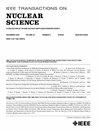利用能谱叠加法获得硼中子俘获治疗的中子能谱
IF 1.9
3区 工程技术
Q3 ENGINEERING, ELECTRICAL & ELECTRONIC
引用次数: 0
摘要
中子能谱和通量率是中子俘获治疗(NCT)中肿瘤吸收剂量和疗效的关键决定因素。肿瘤深度和形态的变化,加上加速器束强度的波动,使得快速获得准确的中子能谱具有挑战性。本研究开发了一种能量谱叠加方法(ESSM),通过从预先计算的中子输运数据库中检索参数,实现快速中子谱重建。采用三层氟化铝(AlF3)-32.5 cm、CaF2-22.5 cm和氟化钛(TiF3)-2 cm的梁形组件(BSA)验证了该方法。与传统的基于仿真的方法相比,ESSM方法获得的能谱具有更好的平滑性和更好的统计质量。对于质子轰击靶和中子注入bsa这两个物理过程,相对于ESSM和传统模拟方法的中子通量率分别为0.958和0.996。将这两个物理过程整合后,BSA的发射窗口的通量比为0.977。此外,当计算的粒子数为$3\乘以10^{{8}}$时,等效计算效率提高了16500倍,可以显着减少计算所需的时间。实现的快速计算证明了在图像引导硼NCT (BNCT)过程中实时治疗计划系统(TPS)操作的临床可行性。本文章由计算机程序翻译,如有差异,请以英文原文为准。
The Neutron Energy Spectrum Obtained Using Energy Spectrum Superposition Method for Boron Neutron Capture Therapy
The neutron energy spectrum and fluence rate constitute critical determinants of tumor absorbed dose and therapeutic efficacy in neutron capture therapy (NCT). Variations in tumor depth and morphology, combined with accelerator beam intensity fluctuations, make it challenging to quickly obtain an accurate neutron energy spectrum. This study develops an energy spectrum superposition method (ESSM) that enables rapid neutron spectrum reconstruction through parameter retrieval from precomputed neutron transport databases. The methodology is validated using a beam shape assembly (BSA) with the three-layer moderator of aluminum fluoride (AlF3)-32.5 cm, CaF2-22.5 cm, and titanium fluoride (TiF3)-2 cm. Compared to the traditional simulation-based method, the energy spectrum obtained by ESSM demonstrates improved smoothness and superior statistical quality. For the two physical processes—proton bombardment on the target and neutron injection into the BSA—the neutron fluence rate ratios relative to the ESSM and the traditional simulation-based method were 0.958 and 0.996, respectively. After integrating the two physical processes, the BSA’s emission window demonstrated a fluence rate ratio of 0.977. Furthermore, when the number of calculated particles is $3\times 10^{{8}}$ , the equivalent computation efficiency is a 16500-fold enhancement, which can significantly reduce the time needed to calculate. The achieved rapid calculation demonstrates clinical viability for real-time treatment planning system (TPS) operation during image-guided boron NCT (BNCT) procedures.
求助全文
通过发布文献求助,成功后即可免费获取论文全文。
去求助
来源期刊

IEEE Transactions on Nuclear Science
工程技术-工程:电子与电气
CiteScore
3.70
自引率
27.80%
发文量
314
审稿时长
6.2 months
期刊介绍:
The IEEE Transactions on Nuclear Science is a publication of the IEEE Nuclear and Plasma Sciences Society. It is viewed as the primary source of technical information in many of the areas it covers. As judged by JCR impact factor, TNS consistently ranks in the top five journals in the category of Nuclear Science & Technology. It has one of the higher immediacy indices, indicating that the information it publishes is viewed as timely, and has a relatively long citation half-life, indicating that the published information also is viewed as valuable for a number of years.
The IEEE Transactions on Nuclear Science is published bimonthly. Its scope includes all aspects of the theory and application of nuclear science and engineering. It focuses on instrumentation for the detection and measurement of ionizing radiation; particle accelerators and their controls; nuclear medicine and its application; effects of radiation on materials, components, and systems; reactor instrumentation and controls; and measurement of radiation in space.
 求助内容:
求助内容: 应助结果提醒方式:
应助结果提醒方式:


